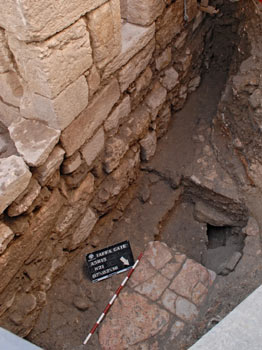Excavated Byzantine street opening to the public in Jerusalem’s Old City
Just out of the offices of the Jewish Quarter Development Corporation: Visitors to Jerusalem’s Old City will soon be able to trace the steps of the ancient Byzantines in an underground passageway connecting the Roman Cardo to the newly renovated 18th century Hurva Synagogue.
The passageway features an arch described by archaeologist Hillel Geva as unique in all of Israel. “It shows where the street split from the Cardo, and has been recovered intact.”
Indeed fellow archaeologist Yuval Baruch, of Israel Antiquities Authority (IAA)’s Jerusalem office, calls the site “a rare and important finding.” It’s an importance that lies in what it has to teach us about how business was conducted 1,500 years ago in Jerusalem, adds Baruch.
To put the new find in historical perspective: The Cardo was originally paved in the 2nd century when Jerusalem was rebuilt following the Bar Kokhba Revolt by Hadrian, and Jews were barred from entering the holy city. However, it was extended south 400 years later by the Byzantine emperor Justinian.
And to Rabbi Shlomo Attias, director of the Jewish Quarter Development Corporation, this discovery symbolizes “the fascinating journey to a world that has been destroyed.”
It was, by all reports, a bustling commercial center. “This street was the center during the most commercially successful period in the history of ancient Jerusalem,” reports Excavation Director Ofer Sion.
The Byzantine Empire was staunchly Christian and greatly valued Jerusalem as a key religious center, prompting them to invest heavily in the holy city. says Sion. “Hundreds of thousands of Christians used to come through the gate.” The visitor will almost be able to hear the cacophany of camels, donkeys, and merchants hawking their wares.
But the ancient Byzantine street may never have seen the light of day were it not for the Madaba Map, discovered in a church in the Hashemite Kingdom of Jordan, which shows what Jerusalem looked like in the 6th-7th centuries. Since its discovery, researchers have been able to unearth a number of structures found on the map.
Previously, Israeli authorities were reluctant to excavate in the area due to projected traffic snags in this already congested neighborhood. But the dust and the detours wll pay off soon when visitors to Jerusalem are able to walk in the footsteps of the ancients. tracing this unique tunnel through the history of the holy city.
By Rachel Avraham, staff writer for United with Israel
